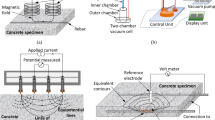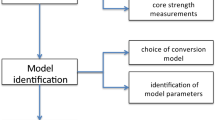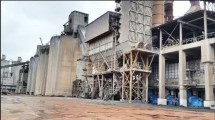Abstract
This paper addresses the use of non-destructive testing (NDT) methods to assess indicators for both the concrete durability (porosity, degree of saturation) and mechanical properties (elasticity modulus, compressive strength) of reinforced concrete structures. NDT results, called “observables”, are obtained by means of ultrasonic or electromagnetic methods and then correlated with these mechanical and durability indicators. The conversion model used to transform observables into indicators depends on the actual concrete mix design. If this conversion model is unavailable for the reinforced structure under study, then the evaluation may be inadequate due to high uncertainty on the results. This paper proposes a calibration methodology to derive a conversion model appropriate for the structure by use of a minimum number of cores in order to improve the on-site evaluation. A motorway bridge is tested and characterized by NDT, after which some cores are extracted for calibration and others for validation. The cores are subsequently non-destructively characterized in the laboratory and/or used to determine indicators by means of standardized destructive methods. The non-destructive calibration protocol on cores is presented first. Next, NDT results recorded in situ and on the corresponding core are compared. Also, durability indicators deduced from on-site NDT measurements in addition to calibration are compared with reference durability indicators that have been independently determined by standard destructive methods. Results obtained by analyzing more than 1600 data fully validate the tested calibration methodology.










Similar content being viewed by others
References
Bungey JH, Millard SG (1996) Testing of concrete structures, 3rd edn. Blackie Academic & Professional, Chapman & Hall, Glasgow
McCann DM, Forde MC (2001) Review of NDT methods in the assessment of concrete and masonry structures. NDT E Int 34(2):71–84
Orcesi A, Frangopol DM (2011) Optimization of bridge maintenance strategies based on structural health monitoring information. Struct Saf 33(1):26–41. https://doi.org/10.1016/j.strusafe.2010.05.002
Salin J, Garnier V, Dérobert X, Martini V, Balayssac J-P, Villain G, Fardeau V (2014) Recueil de recommandations - Analyse et Capitalisation pour le Diagnostic des Constructions, Concevoir et Construire pour le Développement Durable. Projet C2D2-ACDC
Baroghel-Bouny V et al (2007) Concrete design for a given structure service life—durability management with regard to reinforcement corrosion and alkali-silica reaction—state of the art and guide for the implementation of a predictive performance approach based upon durability indicators. Scientific and technical documents AFGC, (French version 2004), English version
Alexander M, Ballim Y, Stanish K (2008) A framework for use of durability indexes in performance-based design and specifications for reinforced concrete structures. Mater Struct 41:921–936. https://doi.org/10.1617/s11527-007-9295-0
Bentur A, Diamond S, Berke NS (1997) Steel corrosion in concrete—fundamentals and civil engineering practice. E&FN SPON, London
Raharinaivo A, Arliguie G, Chaussadent T, Grimaldi G, Pollet V, Tache G (1998) La corrosion et la protection des aciers dans le béton. Presses de l’école nationale des Ponts et Chaussées, Paris
Hernández MG, Izquierdo MAG, Ibáñez A, Anaya JJ, Ullate LG (2000) Porosity estimation of concrete by ultrasonic NDE. Ultrasonics 38(1–8):531–533
Lafhaj Z, Goueygou M, Djerbi A, Kaczmarek M (2006) Correlation between porosity, permeability and ultrasonic parameters of mortar with variable water/cement ratio and water content. Cem Concr Res 36(4):625–633. https://doi.org/10.1016/j.cemconres.2005.11.009
Garnier V, Piwakowski B, Abraham O, Villain G, Payan C, Chaix J-F (2013) Acoustical techniques for concrete evaluation: improvements, comparisons and consistencies. Constr Build Mater 43(6):598–613. https://doi.org/10.1016/j.conbuildmat.2013.01.035
Villain G, Sbartaï ZM, Dérobert X, Garnier V, Balayssac J-P (2012) Durability diagnosis of a concrete structure in a tidal zone by combining NDT methods: laboratory tests and case study. Constr Build Mater 37:893–903. https://doi.org/10.1016/j.conbuildmat.2012.03.014
Ohdaira E, Masuzawa N (2000) Water content and its effect on ultrasound propagation in concrete—the possibility of NDE. Ultrasonics 38(1–8):546–552. https://doi.org/10.1016/S0041-624X(99)00158-4
Robert A (1998) Dielectric permittivity of concrete between 50 MHz and 1 GHz and GPR measurements for building materials evaluation. J Appl Geophys 40:89–94
Soutsos MN, Bungey JH, Millard SG, Shaw MR, Patterson A (2001) Dielectric properties of concrete and their influence on radar testing. NDT E Int 34(6):419–425
Dérobert X, Iaquinta J, Klysz G, Balayssac JP (2008) Use of capacitive and GPR techniques for non-destructive evaluation of cover concrete. NDT E Int 41:44–52
Sbartaï ZM, Laurens S, Rhazi J, Balayssac JP, Arliguie G (2007) Using radar direct wave for concrete condition assessment: correlation with electrical resistivity. J Appl Geophys 62(4):361–374
Hugenschmidt J, Loser R (2008) Detection of chlorides and moisture in concrete structures with GPR. Mater Struct 41:785–792
Lai WL, Kind T, Kruschwitz S, Wöstmann J, Wiggenhauser H (2014) Spectral absorption of spatial and temporal ground penetrating radar signals by water in construction materials. NDT E Int 67:55–63
Kwon SJ, Feng MQ, Park SS (2010) Characterization of electromagnetic properties for durability performance and saturation in hardened cement mortar. NDT E Int 43(2):86–95. https://doi.org/10.1016/j.ndteint.2009.09.002
Polder R, Andrade C, Elsener B, Vennesland Ø, Gulikers J, Weidert R, Raupach M (2000) Test methods for on site measurement of resistivity of concrete. Mater Struct 33(10):603–611. https://doi.org/10.1007/BF02480599
van Noort R, Hunger M, Spiesz P (2016) Long-term chloride migration coefficient in slag cement-based concrete and resistivity as an alternative test method. Constr Build Mater 115:746–759. https://doi.org/10.1016/j.conbuildmat.2016.04.054
Hallaji M, Seppänen A, Pour-Ghaz M (2015) Electrical resistance tomography to monitor unsaturated moisture flow in cementitious materials. Cem Concr Res 69:10–18. https://doi.org/10.1016/j.cemconres.2014.11.007
Du Plooy R, Villain G, Palma Lopes S, Ihamouten A, Dérobert X, Thauvin B (2015) Electromagnetic non-destructive evaluation techniques for the monitoring of water and chloride ingress into concrete: a comparative study. Mater Struct 48:369–386. https://doi.org/10.1617/s11527-013-0189-z
Tumidajski P, Schumacher A, Perron S, Gu P, Beaudoin J (1996) On the relationship between porosity and electrical resistivity in cementitious systems. Cem Concr Res 26(4):539–544
Maierhofer C, Zacher G, Kohl C, Wöstmann J (2008) Evaluation of radar and complementary echo methods for NDT of concrete elements. J Nondestr Eval 27:47–57
Breysse D, Klysz G, Dérobert X, Sirieix C, Lataste J-F (2008) How to combine several non-destructive techniques for a better assessment of concrete structures. Cem Concr Res 38(6):783–793. https://doi.org/10.1016/j.cemconres.2008.01.016
Sbartaï ZM, Breysse D, Larget M, Balayssac J-P (2012) Combining NDT techniques for improving concrete properties evaluation. Cem Concr Compos 34(6):725–733. https://doi.org/10.1016/j.cemconcomp.2012.03.005
Alani AM, Aboutalebi M, Kilic G (2014) Integrated health assessment strategy using NDT for reinforced concrete bridges. NDT E Int 61:80–94. https://doi.org/10.1016/j.ndteint.2013.10.001
Rivard P, Saint-Pierre F (2009) Assessing alkali-silica reaction damage to concrete with non-destructive methods: from the lab to the field. Constr Build Mater 23:902–909. https://doi.org/10.1016/j.conbuildmat.2008.04.01
Garnier V, Martini D, Salin J, Fardeau V, Sbartaï Z M, Breysse D, Piwakowski B, Villain G, Abraham O, Balayssac J-P (2014) Non destructive testing of concrete: transfer from laboratory to on-site measurement. In: 7th European workshop on structural health monitoring, Nantes, France, 8–11 July 2014
Aggelis DG, Shiotani T (2008) Surface wave dispersion in cement-based media: inclusion size effect. NDT E Int 41(5):319–325. https://doi.org/10.1016/j.ndteint.2008.01.010
Dérobert X, Villain G (2017) Development of a multi-linear quadratic experimental design for the EM characterization of concretes in the radar frequency-band. Constr Build Mater 136:237–245. https://doi.org/10.1016/j.conbuildmat.2016.12.061
Gomez-Cardenas C (2015) Outils d’aide à l’optimisation des campagnes d’essais non destructifs sur ouvrages en béton armé, PhD report, Université de Toulouse, 4 Dec 2015
Balayssac J-P, Laurens S, Arliguie G, Breysse D, Garnier V, Dérobert X, Piwakowski B (2012) Description of the general outlines of the French project SENSO—quality assessment and limits of different NDT methods. Constr Build Mater 35:131–138. https://doi.org/10.1016/j.conbuildmat.2012.03.003
Benmeddour F, Villain G, Abraham O, Choinska M (2012) Development of an ultrasonic experimental device to characterise concrete for structural repair. Constr Build Mater 37(12):934–942. https://doi.org/10.1016/j.conbuildmat.2012.09.038
Balayssac J-P, Garnier V (eds) (2017) Non-destructive testing and evaluation of civil engineering structures. Elsevier, Amsterdam. ISBN 9780081023051
Adous M, Queffelec P, Laguerre L (2006) Coaxial/cylindrical transition line for broadband permittivity measurement of civil engineering materials. Meas Sci Technol 17:2241–2246
Villain G, Ihamouten A, Dérobert X (2017) Determination of concrete water content by coupling electromagnetic methods: coaxial/cylindrical transition line with capacitive probes. NDT E Int 88:59–70. https://doi.org/10.1016/j.ndteint.2017.02.004
Du Plooy R, Palma Lopes S, Villain G, Dérobert X (2013) Development of a multi-ring resistivity cell and multi-electrode resistivity probe for investigation of cover concrete condition. NDT E Int 54:27–36. https://doi.org/10.1016/j.ndteint.2012.11.007
Lataste J-F, Sirieix C, Breysse D, Frappa M (2003) Electrical resistivity measurement applied to cracking assessment on reinforced concrete structures in civil engineering. NDT E Int 36(6):383–394. https://doi.org/10.1016/S0963-8695(03)00013-6
Sansalone MJ, Streett WB (1997) Impact echo: non-destructive evaluation of concrete and masonry. Bullbrier Press, Ithaca
Villain G, Le Marrec L, Rakotomanana L (2011) Determination of the bulk elastic moduli of various concretes by resonance frequency analysis of slabs submitted to impact echo. Eur J Environ Civ Eng 15(4):601–617. https://doi.org/10.1080/19648189.2011.9693350
AFPC-AFREM (1997) Compte-rendu des journées techniques de l’AFPC-AFREM, Durabilité des Bétons, Méthodes recommandées pour la mesure des grandeurs associées à la durabilité. 11 et 12 décembre 1997, Toulouse
EN 12390-3: 2009 Testing hardened concrete. Compressive strength of test specimens
EN 13412: 2006 Products and systems for the protection and repair of concrete structures. Test methods. Determination of modulus of elasticity in compression
Zhou Q, Glasser FP (2001) Thermal stability and decomposition mechanisms of ettringite at < 120°C. Cem Concr Res 31(9):1333–1339. https://doi.org/10.1016/S0008-8846(01)00558-0
EN 13791: 2007 Assessment of in situ compressive strength in structures and precast concrete components
Acknowledgements
The study presented herein is part of a French research project (C2D2-ACDC) conducted within the Urban and Civil Engineering Network (RGCU) and France’s Ministry of Ecology, Sustainable Development and Energy (MEDDE). Thus, this research was funded by the RGCU Network and Ministry of Ecology, Sustainable Development and Energy. The authors would especially like to thank MEDDE’s DRIEA Directorate. The authors are also grateful to both J. Salin (EDF) and V. Fardeau (CEREMA) for their valuable collaboration, as well as to O. Coffec and A. Joubert (IFSTTAR) for their high-level technical support.
Author information
Authors and Affiliations
Corresponding author
Ethics declarations
Conflict of interest
The authors declare that they have no conflict of interest.
Rights and permissions
About this article
Cite this article
Villain, G., Garnier, V., Sbartaï, Z.M. et al. Development of a calibration methodology to improve the on-site non-destructive evaluation of concrete durability indicators. Mater Struct 51, 40 (2018). https://doi.org/10.1617/s11527-018-1165-4
Received:
Accepted:
Published:
DOI: https://doi.org/10.1617/s11527-018-1165-4




